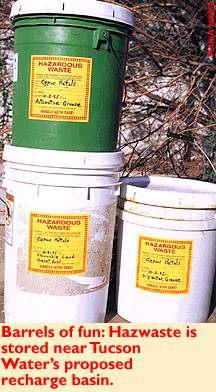REMEMBER THE TV ads opponents of the 1987 All Recharge Initiative ran showing water being recharged through an area filled with dirty diapers and car batteries?
If Tucson Water has its way with locating a pilot recharge project north of Green Valley, those scare-ads may not be far from the truth.
Tucson Water, on the advice of consultants, has selected a 600-acre site roughly 100 feet from an abandoned mineral processing plant which employed hazardous chemicals. The site is located north of Green Valley about a mile east of the Interstate 19 interchange on Pima Mine Road between the Santa Cruz River on the west and the Old Nogales Highway and the Southern Pacific Railroad line on the east. Directly south of the parcel are the pecan groves owned by the Farmers Investment Company.
Last week Tucson Water public information specialist Mitchell B. Basefsky told The Weekly the city has already gone to court to condemn the parcel and is now negotiating with the owners, representatives of ASARCO copper mines, to determine a purchase price. Basefsky says the city has assessed the value of the parcel at $290,000.
 The proposed recharge basin is down-gradient from the former
chemical processing plant. The underground water flow would be
south to north or from the plant to the recharge basin, says George
Barr, a retired hydrologist and engineer.
The proposed recharge basin is down-gradient from the former
chemical processing plant. The underground water flow would be
south to north or from the plant to the recharge basin, says George
Barr, a retired hydrologist and engineer.
A 1991 document prepared for Bruce Johnson, Jim Spain and Ralph Marra of Tucson Water by consultants from CH2M Hill identify the empty complex of buildings as once being owned by the Cyprus Metals Co.
The city was unable to provide The Weekly with an environmental assessment report of the area. According to officials in the city's real estate department, they conducted a preliminary review of several photographs and found nothing unusual. "So we didn't feel the need to do a more in-depth review," one official explained.
The grounds surrounding the plant show traces of large-scale dumping of chemicals into cement channels which flowed into the nearby Santa Cruz River.
A sign on the fence surrounding the plant warns: "Hazardous Waste Materials!"
The residue of chemical vapors which still waft around the plant are, even today, enough to irritate one's throat, face and hands.
The plant's main structure, a large masonry building, shows signs of what could be chemical flash burns on its north, west and southern exteriors. Around the east side of the building are several tubs marked as hazardous waste.
A map supplied by the city's real estate department shows the location of two fuel storage tanks on the plant's grounds. The tanks do not appear as surface structures, suggesting the possibility of underground storage.
The map also identifies a large tailings, or waste pond, 20 to 30 yards directly south of the plant and within a softball toss of the Santa Cruz. What went into the pond is anybody's guess, says Barr.
Two Tucson-area high school science teachers who happened on the scene while The Weekly was conducting its investigation pointed out how all the metal in and around the plant showed signs of being dissolved by metal-eating chemicals.
The teachers were especially interested in the railroad tracks inside the plant's yard. The tracks looked like tree branches which, under intense heat, had charcoaled into small pieces. The teachers referred to the tracks being "dissolved" by exposure to chemicals.
On a railroad spur in front of the plant, Southern Pacific Railroad also appears to have left evidence of its chemical cargo. Hardened stalagmite-like goop fouls the rail ties of a wood-and-steel trestle spanning the 150-foot gap of the Santa Cruz River just 10 feet west of the plant's fence line.
Residents nearby were surprised to hear the city was planning to use the 600-acre site for a future recharge basin. They told The Weekly they were concerned about their personal health.
One person who lives near the city's proposed recharge site says the birds keep dying around her property. In the last month, she says, she has found "about 20 or so dead birds."
"What's going on?" she asks.
Good question--why such a sloppy job on the part of the city? Why no environmental assessment? Does the city really want recharge to succeed?





